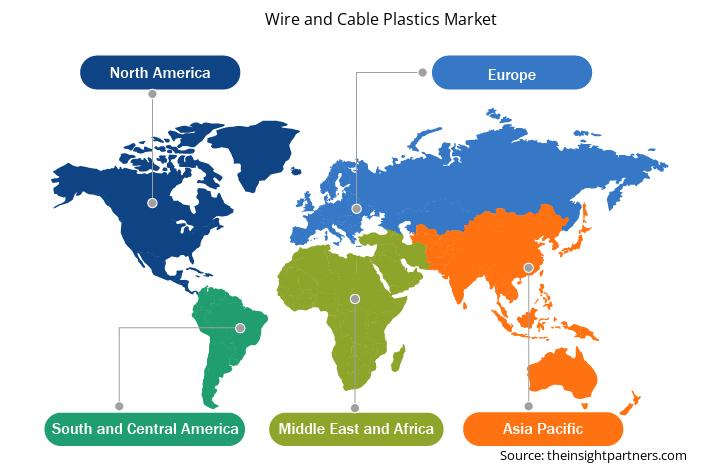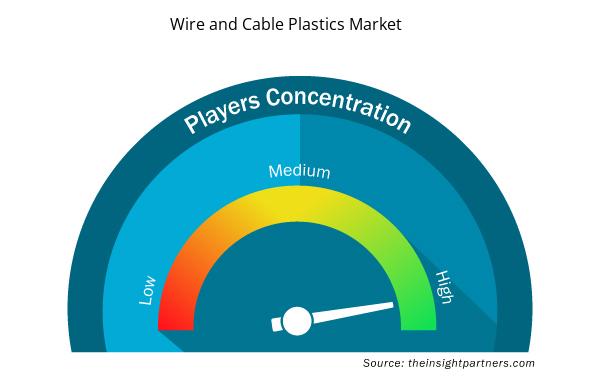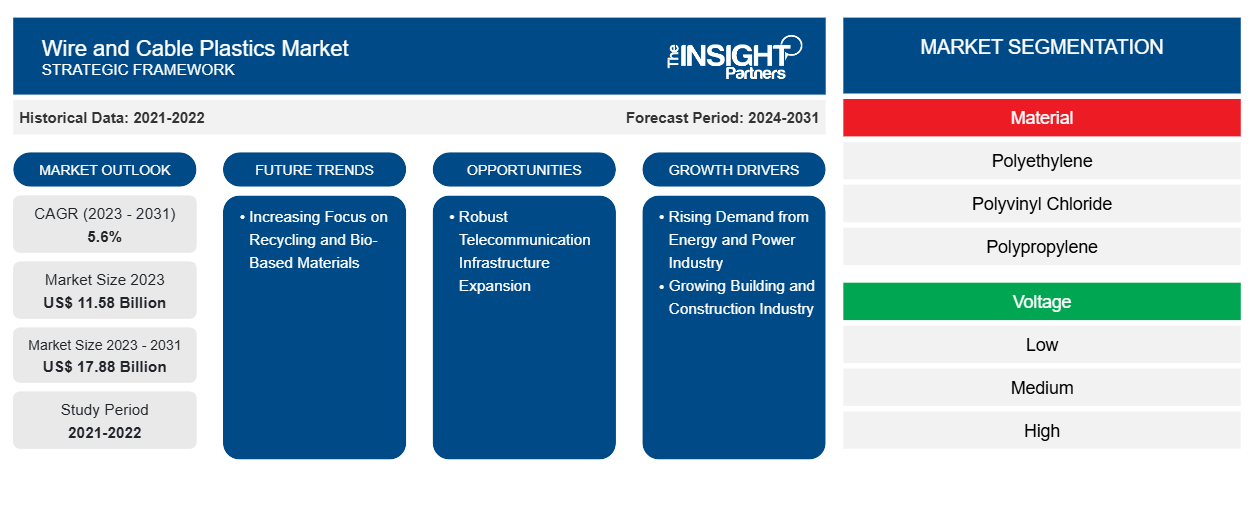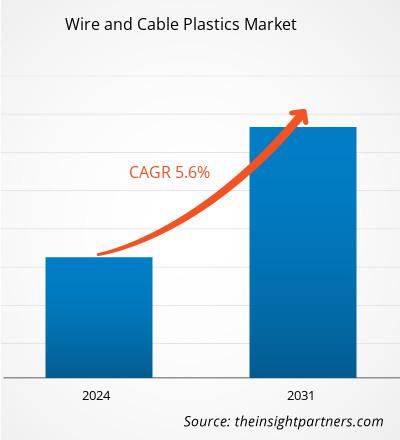电线电缆塑料市场规模预计将从 2023 年的 115.8 亿美元增至 2031 年的 178.8 亿美元;预计 2023-2031 年期间市场复合年增长率将达到 5.6%。人们对回收和生物基材料的日益关注预计将在未来几年为市场带来新的趋势。
电线电缆塑料市场分析
能源和电力行业对电线电缆塑料的需求正在大幅增长,这得益于全球向先进能源基础设施、可再生能源整合以及老化电力系统的现代化转型。塑料,包括聚乙烯 (PE)、聚氯乙烯 (PVC) 和交联聚乙烯 (XLPE),是电线和电缆绝缘、护套和保护不可或缺的材料。这些塑料具有独特的性能,例如柔韧性、电阻、耐用性和成本效益,使其成为满足行业日益增长的需求不可或缺的材料。随着太阳能、风能和水力发电等可再生能源的利用率不断提高,对坚固可靠的电缆解决方案的需求也在不断增加。这些能源系统通常在具有挑战性的环境中运行,电缆暴露在极端温度、紫外线辐射和潮湿环境中。偏远和服务不足地区(尤其是发展中国家)对电气化的日益关注也推动了这种需求。
电线电缆塑料市场概况
塑料用作电线和电缆的护套和绝缘材料。电线和电缆常用的塑料有聚乙烯、聚氯乙烯、聚丙烯、交联聚乙烯和热塑性弹性体等。塑料绝缘电线和电缆在住宅、商业和工业应用中得到广泛使用,因为它们可以安全地为电气设备提供电力、数据和语音通信。电线和电缆用于建筑、汽车、电气和电子、航空航天和国防、电信、石油和天然气、能源和电力等行业。
推动电线电缆塑料市场发展的主要因素包括能源和电力行业需求的不断增长以及建筑业的蓬勃发展。全球能源和电力行业正在经历大幅增长,这得益于全球向先进能源基础设施和可再生能源整合的转变。
定制此报告以满足您的需求
您可以免费定制任何报告,包括本报告的部分内容、国家级分析、Excel 数据包,以及为初创企业和大学提供优惠和折扣
- 获取此报告的关键市场趋势。这个免费样品将包括数据分析,从市场趋势到估计和预测。
电线电缆塑料市场驱动因素和机遇
建筑业蓬勃发展
建筑业的增长受到多种因素的推动,包括基础设施建设需求的不断增长、住宅和商业建筑的兴起以及现代电力系统的进步。随着全球人口的增长和城市化进程的加快,对电力和通信网络的需求激增,而这两者都依赖于电线和电缆的有效利用。电线对于家庭、办公室、学校、医院和其他关键基础设施的供电至关重要。此外,现代建筑中智能技术的集成,包括智能照明、暖通空调系统和安全解决方案,推动了对能够支持更高功率负载和数据传输的先进电缆的需求。
在欧洲,英国、奥地利、意大利和法国等国家人口不断增长,城市化进程加快,导致对更多住房的需求迫切。为此,这些国家的私人开发商和政府都启动了大规模的住房项目,以缓解住房短缺问题。例如,根据 2021-2026 年经济适用房计划,英国政府计划提供多达 18 万套新房。从高层公寓和郊区住宅到豪华庄园和经济适用房,各种住宅开发都需要各种各样的电线和电缆。这些产品为寻求能够承受欧洲各国不同气候的现代高性能电线和电缆的房主提供了解决方案。在建筑行业,创新耐用的电线和电缆对于为现代基础设施供电、支持数字连接以及确保建筑系统的安全和效率至关重要。因此,不断发展的建筑和建筑行业推动了电线电缆塑料市场的增长。
电信基础设施强劲扩张
在技术进步和互联网普及率不断提高的推动下,全球电信行业正在不断扩张,对坚固可靠的电缆基础设施的需求也随之增加。这种需求直接影响了制造电信电缆(包括光纤电缆、同轴电缆和以太网电缆)所用塑料的消耗,这些电缆依靠 PE、PVC 和 PP 等材料进行绝缘、护套和耐用性。由于 5G 技术需要高容量光纤电缆来实现无缝数据传输,因此电信行业需要卓越的质量,以增强对湿气、热量和紫外线辐射等环境因素的保护。此外,数据中心和云服务器对于存储和处理大量数据至关重要,并且需要广泛的电缆网络来进行配电、数据传输和冷却系统。塑料在为这些电缆提供绝缘和耐用性方面发挥着至关重要的作用,确保了运行效率和安全性。随着企业和政府投资建设新的数据中心和升级现有的数据中心,未来对电线电缆应用的高质量、耐热和阻燃塑料的需求预计将会增加。
电线电缆塑料市场报告细分分析
有助于电线电缆塑料市场分析的关键部分是材料、电压和最终用途行业。
- 根据材料,电线电缆塑料市场细分为聚乙烯、聚氯乙烯、聚丙烯、交联聚乙烯、热塑性弹性体等。交联聚乙烯部分在 2023 年占据了电线电缆塑料市场的最大份额。
- 根据电压,市场分为低、中、高和超高。2023 年,低电压市场占据了电线电缆塑料市场的主导地位。
- 根据最终用途行业,市场细分为建筑、汽车、电气和电子、航空航天和国防、电信、石油和天然气、能源和电力等。2023 年,建筑行业占据了电线电缆塑料市场的主导地位。
电线电缆塑料市场份额按地区分析
电线电缆塑料市场报告的地理范围主要分为五个区域:北美、亚太、欧洲、中东和非洲、南美和中美。
预计亚太地区将在预测期内占据市场主导地位。由于汽车、电子、建筑和能源与电力行业的不断发展,亚太地区是电线电缆塑料利用的主要市场之一。亚太地区是消费电子产品领域的全球领导者,三星、索尼和小米等大公司处于创新前沿。亚太地区是消费电子产品生产的全球中心,中国、韩国、日本和印度等国家拥有智能手机、笔记本电脑、可穿戴设备和家用电器的主要制造设施。亚洲各地(尤其是中国和韩国)对电子产品生产设施的投资加速了电线电缆塑料的采用,以满足高性能消费电子设备的技术需求。
亚太地区建筑业的不断扩张是市场的主要驱动力,因为正在进行的住宅、商业和工业项目需要高效的配电系统。电线电缆塑料在确保这些应用的安全性、耐用性和绝缘性方面发挥着至关重要的作用。此外,政府主导的加强可再生能源采用的举措,如太阳能和风能项目,进一步增加了对耐用和耐候电缆材料的需求。
电线电缆塑料市场区域洞察
Insight Partners 的分析师已详尽解释了预测期内影响电线电缆塑料市场的区域趋势和因素。本节还讨论了电线电缆塑料市场在北美、欧洲、亚太地区、中东和非洲以及南美和中美的细分市场和地理位置。

- 获取电线电缆塑料市场的区域特定数据
电线电缆塑料市场报告范围
| 报告属性 | 细节 |
|---|---|
| 2023 年的市场规模 | 115.8亿美元 |
| 2031 年市场规模 | 178.8亿美元 |
| 全球复合年增长率(2023 - 2031) | 5.6% |
| 史料 | 2021-2022 |
| 预测期 | 2024-2031 |
| 涵盖的领域 | 按材质
|
| 覆盖地区和国家 | 北美
|
| 市场领导者和主要公司简介 |
|
电线电缆塑料市场参与者密度:了解其对业务动态的影响
电线电缆塑料市场正在快速增长,这得益于最终用户需求的不断增长,而这些需求又源于消费者偏好的不断变化、技术进步以及对产品优势的认识不断提高等因素。随着需求的增加,企业正在扩大其产品范围,进行创新以满足消费者的需求,并利用新兴趋势,从而进一步推动市场增长。
市场参与者密度是指在特定市场或行业内运营的企业或公司的分布情况。它表明在给定市场空间中,相对于其规模或总市场价值,有多少竞争对手(市场参与者)存在。
在电线电缆塑料市场运营的主要公司有:
- 陶氏化学公司
- 埃克森美孚公司
- 利安德巴塞尔工业公司
- 索尔维公司
- 北欧化工公司
- 巴斯夫
免责声明:上面列出的公司没有按照任何特定顺序排列。

- 了解电线电缆塑料市场的主要参与者概况
电线电缆塑料市场新闻及最新发展
电线电缆塑料市场通过收集来自一手和二手研究的定性和定量数据进行评估,其中包括重要的公司出版物、协会数据和数据库。电线电缆塑料市场的一些关键发展如下所列:
- 巴斯夫 SE 宣布推出醚基热塑性聚氨酯:Elastollan 1400。该产品旨在提供出色的水解和微生物抗性,结合稳定的加工行为和良好的压缩变形性能。(来源:巴斯夫 SE,公司网站,2024 年 10 月)
- 陶氏公司推出了一系列 REVOLOOP 再生塑料树脂,将消费后回收 (PCR) 材料融入电缆护套中。此次发布旨在满足消费者可持续发展目标的需求。(来源:陶氏,公司网站,2023 年 9 月)
- Borealis AG 宣布推出 Queo 可再生能源系列,这是一系列基于可再生原料的弹性体和弹性体。此次发布旨在满足对可持续解决方案日益增长的需求。(来源:Borealis AG,公司网站,2023 年 5 月)
电线电缆塑料市场报告内容及交付成果
“电线电缆塑料市场规模和预测(2021-2031 年)”报告对以下领域进行了详细的市场分析:
- 电线电缆塑料市场规模及范围内所有主要细分市场的预测
- 电线电缆塑料市场趋势,以及驱动因素、限制因素和关键机遇等市场动态
- 详细的波特五力分析和 SWOT 分析
- 电线电缆塑料市场分析涵盖主要市场趋势、国家框架、主要参与者、法规和最新的市场发展。
- 行业格局和竞争分析,涵盖市场集中度、热图分析、知名企业以及电线电缆塑料市场的最新发展
- 详细的公司简介
- 历史分析(2 年)、基准年、预测(7 年)及复合年增长率
- PEST 和 SWOT 分析
- 市场规模价值/数量 - 全球、区域、国家
- 行业和竞争格局
- Excel 数据集


- Energy Recovery Ventilator Market
- Greens Powder Market
- Photo Editing Software Market
- Single Pair Ethernet Market
- Fertilizer Additives Market
- Excimer & Femtosecond Ophthalmic Lasers Market
- HVAC Sensors Market
- Adaptive Traffic Control System Market
- Legal Case Management Software Market
- Dealer Management System Market

Report Coverage
Revenue forecast, Company Analysis, Industry landscape, Growth factors, and Trends

Segment Covered
This text is related
to segments covered.

Regional Scope
North America, Europe, Asia Pacific, Middle East & Africa, South & Central America

Country Scope
This text is related
to country scope.
常见问题
The rising demand from the energy & power industry and the growing building and construction industry are driving the market.
The increasing focus on recycling and bio-based materials is expected to emerge as a future trend in the market.
In 2023, Asia Pacific held the largest share of the global wire and cable plastics market owing to the growing automotive, electronics, construction, and energy & power industries.
The cross-linked polyethylene segment held the largest share of the global wire and cable plastics market in 2023.
The market is expected to register a CAGR of 5.6% during 2023–2031.
Dow Inc, Exxon Mobil Corp, LyondellBasell Industries NV, Solvay SA, Borealis AG, BASF SE, Saudi Basic Industries Corp, LG Chem Ltd, Arkema SA, and Celanese Corp. are among the key players operating in the wire and cable plastics market.
Trends and growth analysis reports related to Chemicals and Materials : READ MORE..
The List of Companies - Wire and Cable Plastics Market
- Dow Inc
- Exxon Mobil Corp
- LyondellBasell Industries NV
- Solvay SA
- Borealis AG
- BASF SE
- Saudi Basic Industries Corp
- LG Chem Ltd
- Arkema SA
- Celanese Corp
The Insight Partners performs research in 4 major stages: Data Collection & Secondary Research, Primary Research, Data Analysis and Data Triangulation & Final Review.
- Data Collection and Secondary Research:
As a market research and consulting firm operating from a decade, we have published and advised several client across the globe. First step for any study will start with an assessment of currently available data and insights from existing reports. Further, historical and current market information is collected from Investor Presentations, Annual Reports, SEC Filings, etc., and other information related to company’s performance and market positioning are gathered from Paid Databases (Factiva, Hoovers, and Reuters) and various other publications available in public domain.
Several associations trade associates, technical forums, institutes, societies and organization are accessed to gain technical as well as market related insights through their publications such as research papers, blogs and press releases related to the studies are referred to get cues about the market. Further, white papers, journals, magazines, and other news articles published in last 3 years are scrutinized and analyzed to understand the current market trends.
- Primary Research:
The primarily interview analysis comprise of data obtained from industry participants interview and answers to survey questions gathered by in-house primary team.
For primary research, interviews are conducted with industry experts/CEOs/Marketing Managers/VPs/Subject Matter Experts from both demand and supply side to get a 360-degree view of the market. The primary team conducts several interviews based on the complexity of the markets to understand the various market trends and dynamics which makes research more credible and precise.
A typical research interview fulfils the following functions:
- Provides first-hand information on the market size, market trends, growth trends, competitive landscape, and outlook
- Validates and strengthens in-house secondary research findings
- Develops the analysis team’s expertise and market understanding
Primary research involves email interactions and telephone interviews for each market, category, segment, and sub-segment across geographies. The participants who typically take part in such a process include, but are not limited to:
- Industry participants: VPs, business development managers, market intelligence managers and national sales managers
- Outside experts: Valuation experts, research analysts and key opinion leaders specializing in the electronics and semiconductor industry.
Below is the breakup of our primary respondents by company, designation, and region:

Once we receive the confirmation from primary research sources or primary respondents, we finalize the base year market estimation and forecast the data as per the macroeconomic and microeconomic factors assessed during data collection.
- Data Analysis:
Once data is validated through both secondary as well as primary respondents, we finalize the market estimations by hypothesis formulation and factor analysis at regional and country level.
- Macro-Economic Factor Analysis:
We analyse macroeconomic indicators such the gross domestic product (GDP), increase in the demand for goods and services across industries, technological advancement, regional economic growth, governmental policies, the influence of COVID-19, PEST analysis, and other aspects. This analysis aids in setting benchmarks for various nations/regions and approximating market splits. Additionally, the general trend of the aforementioned components aid in determining the market's development possibilities.
- Country Level Data:
Various factors that are especially aligned to the country are taken into account to determine the market size for a certain area and country, including the presence of vendors, such as headquarters and offices, the country's GDP, demand patterns, and industry growth. To comprehend the market dynamics for the nation, a number of growth variables, inhibitors, application areas, and current market trends are researched. The aforementioned elements aid in determining the country's overall market's growth potential.
- Company Profile:
The “Table of Contents” is formulated by listing and analyzing more than 25 - 30 companies operating in the market ecosystem across geographies. However, we profile only 10 companies as a standard practice in our syndicate reports. These 10 companies comprise leading, emerging, and regional players. Nonetheless, our analysis is not restricted to the 10 listed companies, we also analyze other companies present in the market to develop a holistic view and understand the prevailing trends. The “Company Profiles” section in the report covers key facts, business description, products & services, financial information, SWOT analysis, and key developments. The financial information presented is extracted from the annual reports and official documents of the publicly listed companies. Upon collecting the information for the sections of respective companies, we verify them via various primary sources and then compile the data in respective company profiles. The company level information helps us in deriving the base number as well as in forecasting the market size.
- Developing Base Number:
Aggregation of sales statistics (2020-2022) and macro-economic factor, and other secondary and primary research insights are utilized to arrive at base number and related market shares for 2022. The data gaps are identified in this step and relevant market data is analyzed, collected from paid primary interviews or databases. On finalizing the base year market size, forecasts are developed on the basis of macro-economic, industry and market growth factors and company level analysis.
- Data Triangulation and Final Review:
The market findings and base year market size calculations are validated from supply as well as demand side. Demand side validations are based on macro-economic factor analysis and benchmarks for respective regions and countries. In case of supply side validations, revenues of major companies are estimated (in case not available) based on industry benchmark, approximate number of employees, product portfolio, and primary interviews revenues are gathered. Further revenue from target product/service segment is assessed to avoid overshooting of market statistics. In case of heavy deviations between supply and demand side values, all thes steps are repeated to achieve synchronization.
We follow an iterative model, wherein we share our research findings with Subject Matter Experts (SME’s) and Key Opinion Leaders (KOLs) until consensus view of the market is not formulated – this model negates any drastic deviation in the opinions of experts. Only validated and universally acceptable research findings are quoted in our reports.
We have important check points that we use to validate our research findings – which we call – data triangulation, where we validate the information, we generate from secondary sources with primary interviews and then we re-validate with our internal data bases and Subject matter experts. This comprehensive model enables us to deliver high quality, reliable data in shortest possible time.


 获取此报告的免费样本
获取此报告的免费样本